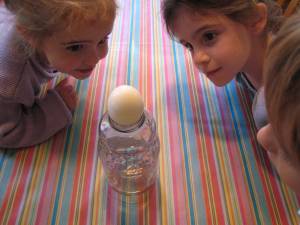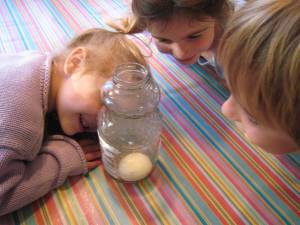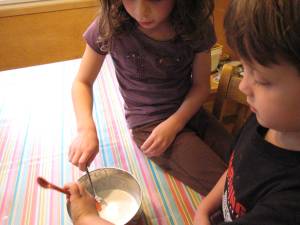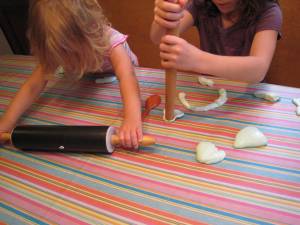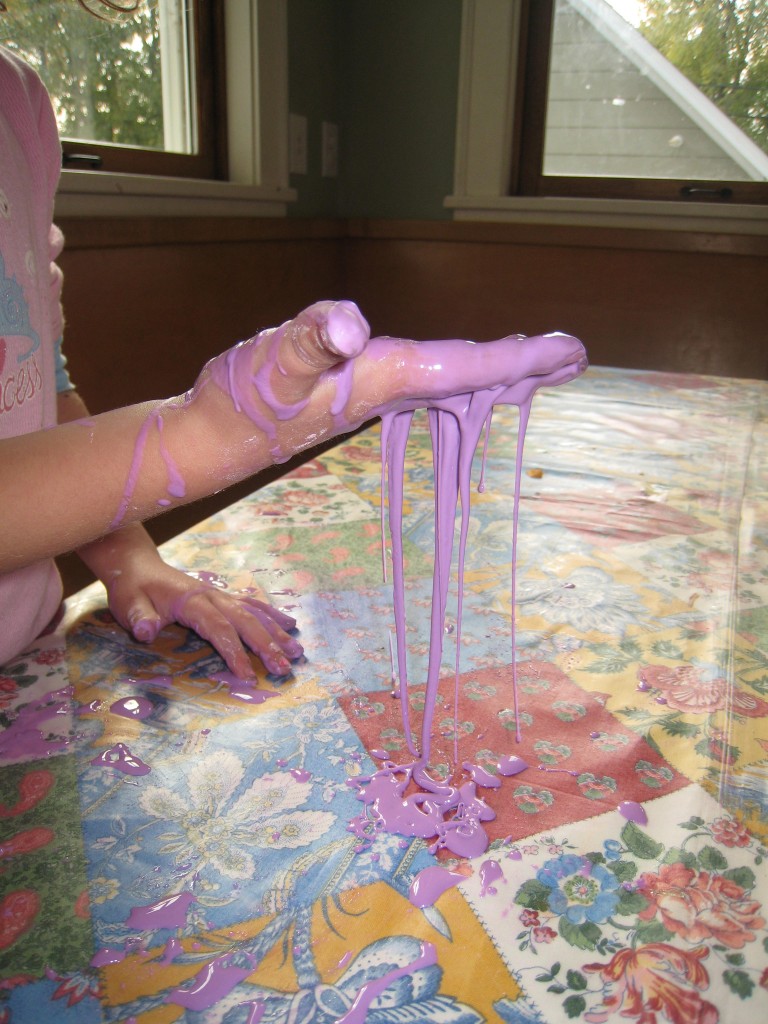Tag: kids’
Fingerprint Fun
- by KitchenPantryScientist
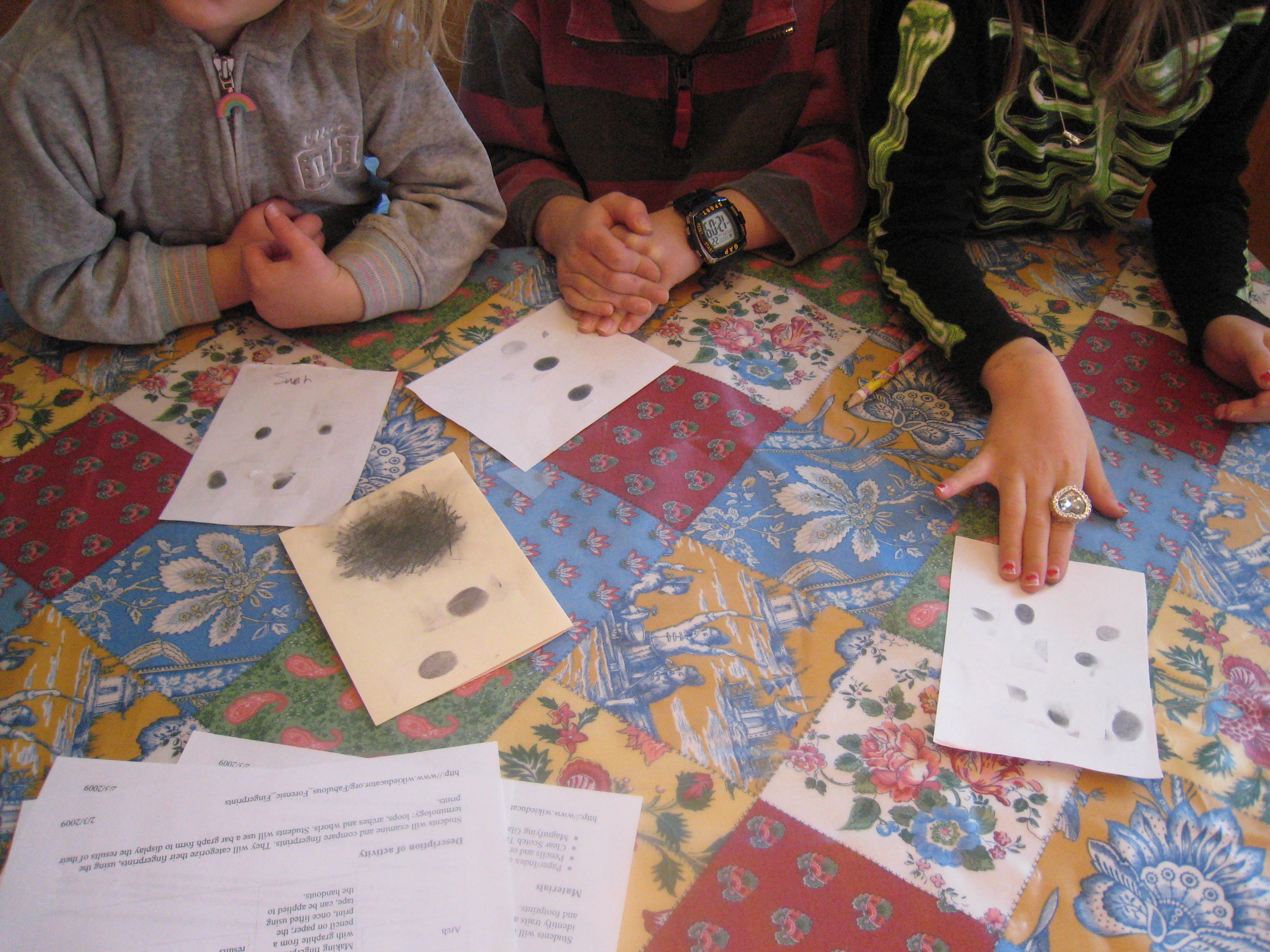
For this project, I thought that it would be fun to mix a little science and a little art. My sister told me that she heard you could make Valentine’s cards using fingerprints. I’ve also heard that it’s pretty easy to lift fingerprints using scotch tape, so I thought we’d give it a try. All you need for the science part is paper, scotch tape and a pencil. For the valentines, you will need an ink pad, paper and markers.
On www.wikieducator.org/Fabulous_Forensic_Fingerprints, I found a fingerprint-lifting technique that works well, even for very young children. Simply take a pencil and scribble on a piece of paper until a small area is covered with the graphite from the pencil lead. Have your child rub his or her finger around in the graphite until it is covered with gray. Then, have your child carefully place their finger on the sticky side of a piece of scotch tape and carefully lift their finger off of the tape. A clear fingerprint should be visible. Place the tape face-down on another piece of paper to preserve the fingerprint.


Your child can then inspect the fingerprint under a magnifying glass, or just with their naked eye. If you go to the wiki website I mentioned, your child can decipher whether they think their fingerprint is a whorl, a loop, or an arch. It is fun to have them trace their hand, fingerprint each finger and thumb, and tape their fingerprints to the appropriate fingers. Your child’s fingerprints would be a great addition to their science notebook! I’ve found that their notebooks are great keepsakes of their drawings and observations at different ages. The kids had a lot of fun with this project and could do it unassisted once I showed them what to do.
For the Valentines, have your children put two fingerprints or thumbprints together in the shape of a heart. Of course, they will also want to make fish, bugs, and who knows what else? I gave my kids some ideas to get them started and they went from there! (It’s fun to add details with markers.) Have fun!

Float or Sink
- by KitchenPantryScientist

You’re never too young to enjoy a good science experiment. This is a great project that requires very few supplies and very little effort for adult involved. It’s easy enough for a toddler to do and is a perfect activity for a cold or rainy day.
-Fill up a large bowl or tub with as much water as you’re comfortable cleaning up. (Safety Mama, if there were one, would remind you to always supervise young children around any amount of water!)
-Place a large towel under the bowl on some waterproof surface. (The kitchen floor works very well for us.)
-Have your child find several small objects around the house that they’d like to use in the experiment. Suggest they find some things that they think will float and some they think will sink. Do a quick check to make sure they won’t destroy anything that you want to keep dry.
-Ask them whether they think the object will float or sink and then let them try it out.
If they want, they can make a chart of their predictions and the results. Your child’s science notebook would be a great place to do this! (see science notebook post if you don’t already have one!)
Here’s some science for you parents, in case your kids want to know what’s happening. You can impress them with your vast knowledge:
One way to see how density affects things is to look at how things sink or float in water.
If something is more dense that water, it will sink, and if less dense than water, it will float.
In case they ask, which they always do:
Density is a measure of how much mass is contained in a given unit volume. Put simply, if mass is a measure of how much ‘stuff’ there is in an object, density is a measure of how tightly that ‘stuff’ is packed together.
Or, just tell them they’ll learn about it in science class someday!
“Spiderman Eye”
- by KitchenPantryScientist
Who knew that some tarantulas can kick off a cloud of tiny barbed hairs that can be very irritating to any creature who gets too close? Be careful while cleaning those cages, tarantula-lovers! Read about one tarantula owner who got an “eyeful” in today’s Science Times http://www.nytimes.com/2010/01/05/health/research/05haza.html?ref=science
Apples and Acids
- by KitchenPantryScientist
One thing I love about doing science with kids is that, regardless of their age, they can participate and enjoy it at some level. This is a perfect example. Even younger children will have fun putting apple slices into cups and watching what happens. Older children can make hypothesis (educated guesses) about what will happen and try to draw conclusions about what happened. I’ll do my best to make it simple to do and easy to understand!
Apples turn brown when they’re cut open and exposed to air. This is the result of oxygen in the air reacting with enzymes and other chemical compounds in the apples. We’re going to observe what happens when you treat apple slices with acids (lemon juice and vinegar) and a base (baking soda and water). We will also watch how fast treated apple slices turn brown compared to an untreated apple slice!
You could ask your child to choose one of the following hypothesis: 1. A solution with acid in it will stop the apples from turning brown so fast. or 2. A solution with acid in it will not change how fast the apples turn brown. Older kids could write their hypothesis in their notebooks!
Materials: an apple, vinegar (white or apple cider), lemon juice, baking soda, water, five clear containers (plastic cups or glasses) labeled as follows: no treatment, water, baking soda, lemon juice, vinegar.
Mix together about 1/2 tsp of baking soda in 1/4 cup water. Add it to the appropriate container. To another container, add 1/4 cup vinegar, to another add 1/4 cup water and to another add 1/4 cup lemon juice. Leave one cup empty for your “no treatment” apple, or the one just exposed to air. Your child can help you do this! Make sure small children don’t rub or splash vinegar or lemon juice in their eyes. Remember, they’re acids! Explain to them that lemon juice and vinager are acids and baking soda makes a basic solution. Water is pretty neutral (neither an acid or a base.) If they want to know more about acids and bases, go to http://library.thinkquest.org/J001539/
Slice the apple and immediately have your child add a slice to each cup, thoroughly coating the apple slices with solution. Pour the solutions out, leaving the apple slices in the cups. Help your child write down or draw how the slices look. They can make a table in their lab notebook to record their observations, with treatment in one column next to appearance in the next column (save room for more columns to note appearance over time.) I had to cover our cups loosely with foil due to the frightening number of fruit flies that have recently invaded my kitchen.
Have them observe the slices in a few hours and over the next few days, recording their observations if they want to . They may want to draw how the slices look over time, or even take pictures for their science notebooks.
Finally, have them draw a conclusion from their observations (data) and record it in their notebook if they want to. Did the solutions keep the apples from turning brown? Was their hypothesis correct? Which solutions worked best? Did both acids (lemon juice and vinegar) help preserve the color? If not, does this suggest that it was something else in the solution, and not just the acid that preserved the color? What did the water do? The base?
You can make it as simple or complicated as you want to! Just make it fun and don’t take over. Let your kids get their hands dirty!
Three Easy Eggsperiments
- by KitchenPantryScientist
I am cooking hard-boiled eggs as I write so that we can do a quick experiment before dinner. My kids will always drop whatever they’re doing to do a science project and I am thrilled to see them so enthusiastic about something that doesn’t involve screen time or sugar.
The first experiment involves dissolving eggshells in vinegar. Put two raw eggs into two juice glasses or jars and cover the eggs with (white or cider) vinegar. Let them sit overnight and see what happens. Before handling the eggs, gently rinse them with water. Only the membrane of the egg will remain, which is like a rubbery balloon.) It’s pretty neat. Have your child draw or record what they observed and how long it took to dissolve the shells in their science notebook. (See earlier post.)
What happened? The shells are dissolved by the vinegar, which is an acid.
The second experiment uses the eggs with the dissolved shells that you made in the one. Return the eggs to two empty glasses or jars. Cover one egg with water and the other with corn syrup. Leave them for 24 hours in the refrigerator and see what happens. Have your child record their results!
What happens? From what I understand, the balloon-like membrane of the soft eggs will let water molecules pass through. The egg will expand appear even more balloon-like as it becomes filled with water. I can’t wait to see what happens with the corn syrup egg. I’m guessing that the membrane may not let the corn-syrup molecules through. That’s my “hypothesis”, but I won’t know until we complete the experiment. Ask your child what they think will happen.
For the final experiment, you will need a glass bottle who’s neck is a little smaller than a hard-boiled egg, and the hard-boiled egg itself. It’s called Egg-in-a-Bottle. I went out to my recycling bin and discovered that my Trader Joe’s grape juice bottle is the perfect size. It obviously requires adult supervision and I have to admit that we’ve had varying sucess with this, but when it works, it’s really neat.
Peel the hard boiled egg, set it on the bottle, and let your children verify that it won’t easily squeeze through. Then, remove the egg, light three matches and drop them into the bottle. They may not stay lit for long, but it doesn’t matter. Do it fairly quickly. I had the best luck dropping them in unlit end first. Then, set the egg back on top of the bottle before the matches go out and watch the egg get sucked into the bottle. (My matches went out just before I put the egg back on top of the bottle, and it still worked.) It’s pretty cool!
Ask your kids what they think happened. Have them draw a picture of the egg in the bottle in their science notebooks! The matches heat the air in the bottle. When the matches go out, the air rapidly cools, decreasing the air pressure in the bottle. The outside air, who’s pressure is higher actually pushes the egg into the bottle as it attempts to equalize the pressure inside of the bottle.
National Geographic Kids Design Contest
- by KitchenPantryScientist
Do you have a child that loves the ocean? My son, a budding marine biologist, is very excited about this National Geographic Kids design contest. Some lucky kid’s winning design will be made into a flag and fly on the National Geographic Ocean Now expedition ship in 2010. Go to http://ow.ly/KnDO for rules and details! Entries must be postmarked by February 20, 2010 and the contest is for kids 8-14 years old (much to my 7-year old daughter’s disappointment.)
Mad Scientist’s Green Slime
- by KitchenPantryScientist
What could be more fun than creating your own green slime to play with? It’s easy to synthesize your own green goo using only Elmer’s glue (the non-washable kind), Borax (found in the laundry detergent section of most stores), green food coloring and water.
In a bowl, have your child mix together about 1/3 cup glue and 1/3 cup water with a spoon or Popsicle stick. These measurements don’t have to be exact. Add a few drops of green food coloring and mix well.
To make the Borax solution, add around a cup of water to a jar. To the water, add about a Tablespoon of Borax. Have your child shake the jar to dissolve as much of the Borax as possible. You are making what is called a saturated solution, so it may not all dissolve! Don’t worry, it will work just fine.
Have your child add about a teaspoon at a time of the Borax solution to the glue/water mix. After each addition, have them stir the mixture together. You should see long strings begin to form and stick together. Keep adding Borax until the mixture doesn’t feel gluey any more. It will form sort of a shiny playdough-like substance. If you add too much Borax solution, it will feel wet. You should be able to just knead it a little to absorb the extra water! The slime is not toxic, but Borax is soap, so don’t let your kids eat it!
I am a biologist and not a chemist, but here is the science, as I understand it.
Mixing Elmer’s glue with water forms a substance called a polymer, which is a long chain of molecules. (A molecule is the smallest amount of a specific chemical substance that can exist alone, like H2O, a single water molecule). The polymer formed by water and glue is called polyvinyl acetate.
The Borax solution (sodium tetraborate) is a cross-linking substance that makes the polymer chains stick together. As more and more chains stick together, they can’t move around and the goo gets thicker and thicker. Eventually, all the chains are bound together and no more Borax solution can be incorporated.
You can store the slime in plastic bags. If you want to make a larger batch, just remember to mix equal amounts of glue and water and add as much Borax solution as needed.
To make your child feel like a “real” scientist, find an old, button up shirt for your child to use as his or her “lab coat”. It’s fun and will protect their clothes. You could even try to find some old safety goggles in your garage for your child to wear, although the ingredients for this project are relatively safe. (Very young children should always be supervised while doing science projects.)
Have fun!
Zooming Fish
- by KitchenPantryScientist

Here’s a fun, easy science project that I discovered a few years ago on pbskids.org/dragonflytv. My children will do it again and again. Even my three year-old joined in, cutting up construction paper into “fish food” and throwing it into the water.
You will need some sort of pan for water (a cake pan will work), construction paper, scissors, and dish soap. Have your child cut out some fish shapes from the paper (around two inches long works well.) See the photo below. Then, have them cut a small slit in the back of the tail. Put a few inches of water in the pan and add the fish. Before the paper soaks up too much water, have your child add a drop of dish soap behind the fish. The fish should zoom across the water. You will have to add fresh water tothe pan if you want to repeat the experiment.

The soap breaks the surface tension of the water. Tell your child to imagine that the surface of the water is a sheet of fabric and the soap is a pair of scissors. The soap cuts through the water, pushing the fish ahead of it. For a more scientific explanation, have your child look up surface tension or visit the dragonfly tv website!
Don’t forget those science notebooks! Have your children write the date, “surface tension” and record their results. They can try using different liquids (like lemon juice) to see if they will break the surface tension. My kids made some fish out of that foam that is used for craft projects so that they wouldn’t soak up the water! Hopefully, the zooming fish will keep your child interested and busy for a while! Click here to see a video on how to make zooming fish.
Cornstarch Goo-Liquid or Solid?
- by KitchenPantryScientist
This experiment is easy, non-toxic and so much fun that it is worth every bit of the mess it makes. Your kids will love it!
All you need is a cup of cornstarch and half a cup of water with a little food coloring in it (purple and green and red would be gross!) Mix the two ingredients to a medium-size bowl with a spoon or your fingers. The goo should be the consistency of syrup.
Now, play with the mixture! You will discover that it behaves like a solid when you agitate it, or move it quickly, and like a liquid when you let it sit still. Pour some onto plates or into bowls if you want to. We poured it directly onto our table which was pretty messy, but lots of fun! Hold a handful on your palm and watch it drip between your fingers! Roll it into a ball. If it gets too dry, just add a little more water. You can easily clean the goo off of flat surfaces using a plastic spatula. Wash it off hands with water.
Cornstarch molecules are like long ropes. When you leave them alone, or move them slowly, they can slide past each other and look like a liquid. However, if you squeeze them, stir them or roll them around in your hands, the ropey molecules look and feel more like a solid. Materials like cornstarch goo are known as non-Newtonian fluids, since they don’t have the normal properties of either a liquid or a solid.
Click here to watch my video on how to make cornstarch goo.


